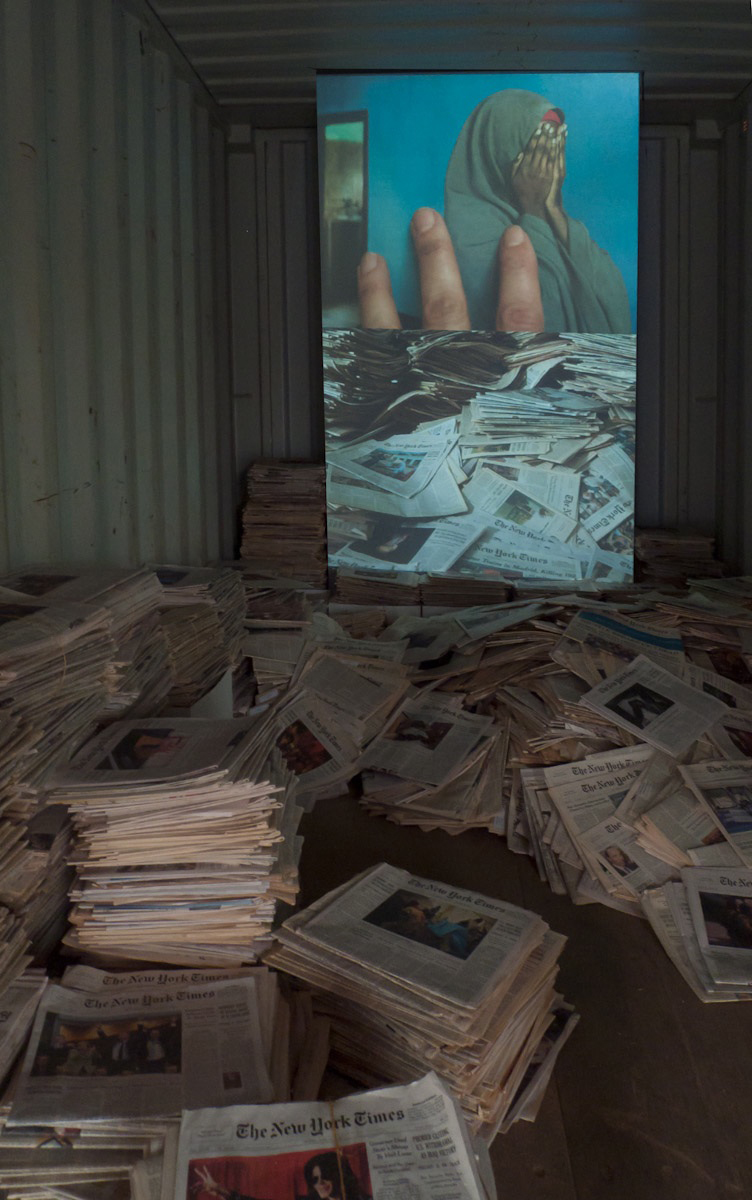
Julienne Schaer, Overview of Photoville, 2012. Courtesy and copyright Julienne Schaer. www.julienneschaer.com
“Welcome to our little town in the shadow of the Brooklyn Bridge. What once thrived as a bustling harbor has been reborn as the glorious Brooklyn Bridge Park, and the temporary home of Brooklyn’s newest settlement: Photoville. A photographic “village” built entirely out of freight containers, in homage to the Brooklyn waterfront’s storied past, Photoville was born out of a simple question: how to create a large-scale, mobile, photographic showcase, that challenges the role of visitor as a passive visual consumer.”
This is the introduction to the small catalog accompanying the latest “destination” in New York photography, which runs from June 22 to July 1, 2012. A grass roots effort, made with love and a lot of volunteers, Photoville (www.photovillenyc.org) represents the kind of funky, local and alternative event that New Yorkers like to create and can’t wait to attend. Organized by United Photo Industries with the help of a number of sponsors and friends, the “pop-up village” consists of a 1,000 foot long “fence” (covered with pictures printed on photographic mesh by Duggal), a plethora of solo exhibitions in freight containers on the uplands of Pier 3 by artists like Wyatt Gallery, Bruce Gilden, Sim Chi Yin and Li Hao as well as shows curated by the New York Times, Magnum, Conveyor Arts, and local art schools like SVA and the Parsons School of Design (among others). A beer garden, lectures, nighttime projections, workshops, food trucks and even a dog run round out the list of “delights to suit all tastes and dispositions” at this unique photo venue in the midst of what has to be one of the most beautiful parks in the Big Apple. The weather was gorgeous this weekend, so we spent a lot of time looking at images, hanging out with friends and just enjoying the sights on the East River.
Lorie Novak, my friend and colleague in the Photography and Imaging Department at New York University, is presenting an installation called “Random Interference” in one of the freight containers. Consisting of front sections of the New York Times collected over many years as well as a live randomized sequence of projected images, hers is a complex, thought-provoking and timely contribution to the exhibition. Making an attempt to translate a 3-dimensional installation into the virtual world of this blog, we are here presenting her artist’s statement, an installation photo and a video from “Random Interference.”
SR

Lorie Novak, Installation View of Random Interference at Photoville, 2012, Courtesy and copyright Lorie Novak. www.lorienovak.com
Lorie Novak: Artist statement
Random Interference explores the afterlife of images and the experience of looking at photographs as a disruptive encounter. Image fragments from my Photographic Interference project are randomly juxtaposed in a continuously changing sequence mimicking our experience of encountering photographs both online and offline.
In all my projects, I use different technologies of representation to recontextualize, recycle, and reuse media imagery, historical photographs, family snapshots (my own and those of others), self-portraits, travel photographs, and audio recordings. Pulling from these archives, I explore memory and transmission, how to visualize absence, and the socio-political meanings of photographs. I question how photographs affect how we know what we know, how personal remembrances and cultural recall intersect, and how photographs influence storytelling and history. These issues have been at the core of my photographs, installations, and web work since the late 1980s. In my constructed photographs and installations, I use scanned newspaper and magazine images. I grab other photos from the Internet. Folders in file cabinets and folders in my computer contain hundreds of images. The images play like filmstrips in my mind.
In the late 1990s, I was clipping more photographs from the newspapers than usual. As it became clear in March 1999 that NATO was going to bomb Serbia, I decided to save the front section of The New York Times once the bombing started. My idea was to have a stack of newspapers that signified a war. When the cease-fire was signed, a true resolution had not been reached, so I kept collecting. The World Trade Center was attacked, and I kept collecting. I have not stopped.
Temporarily relocated from my studio to a shipping container at Photoville are close to 5,000 sections of The New York Times. Photographs of atrocity are everywhere. It is hard to look and hard to look away. Images get under my skin. In making artworks that use and reference this media landscape, I want to cause a rupture in our expectations and speak to our difficult, confusing, and dangerous times where media and photography have simultaneously lost and gained credibility. I am both image-maker and consumer.
Lorie Novak, Video documentation of Random Interference projection. Courtesy and copyright Lorie Novak, 2012.